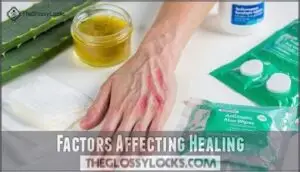This site is supported by our readers. We may earn a commission, at no cost to you, if you purchase through links.

You’ll experience immediate redness, swelling, and possible skin peeling right after the incident.
First-degree wax burns, the most common type, usually resolve in 7-10 days with proper care.
Deeper burns can take up to three weeks or longer.
Your age, overall health, and how quickly you treat the burn all play vital roles in healing speed.
The key is keeping the area clean, moisturized, and protected from further irritation.
Smart aftercare techniques can substantially speed up your recovery process.
Table Of Contents
- Key Takeaways
- How Long Does a Wax Burn Last?
- What is a Wax Burn?
- Difference From Other Burns
- Healing Time for Wax Burns
- Factors Affecting Healing
- Tips for Faster Recovery
- Frequently Asked Questions (FAQs)
- How do you heal a wax burn fast?
- What does a first degree wax burn look like?
- Is Neosporin good for wax burns?
- Does wax burn or just melt?
- How to heal a wax burn quickly?
- Does wax burn leave a scar?
- Is a wax burn a first degree burn?
- How long can wax burn?
- How do I know if I have a wax burn?
- What should I do if I get a wax burn?
- Conclusion
Key Takeaways
- Most wax burns heal within 2-3 weeks, with first-degree burns typically resolving in 7-10 days if you provide proper care immediately after the injury occurs.
- You’ll speed up recovery time by cooling the burn with water for 20 minutes, applying antibiotic ointment, keeping it covered with sterile gauze, and avoiding picking at healing skin.
- Your healing time depends on burn depth, skin sensitivity, age, and how quickly you treat the injury – deeper burns and delayed treatment can extend recovery beyond three weeks.
- You should watch for infection signs like increased redness, pus, or spreading warmth, and consult a healthcare provider if the burn doesn’t improve after a week or shows concerning symptoms.
How Long Does a Wax Burn Last?
A wax-burn timeline depends on several key factors that determine your recovery journey. Most wax burns heal within 3-10 days for minor injuries, while deeper burns may take 2-3 weeks to fully recover.
Burn depth plays the biggest role in healing time. Surface-level burns typically resolve quickly, but burns affecting deeper skin layers need more patience. Your skin sensitivity also matters – some people bounce back faster than others due to their natural healing abilities.
Infection signs like increased redness, pus, or spreading warmth can extend recovery substantially. That’s why proper burn care and consistent aftercare impact your timeline so much.
With good burn treatment including cooling, cleaning, and protecting the area, you’ll minimize scarring potential and speed up burn healing naturally.
What is a Wax Burn?
Imagine this: you’re having a spa day at home when suddenly your skin meets wax that’s hotter than a summer sidewalk. A wax burn is a thermal injury that happens when heated wax contacts your skin, causing damage ranging from mild irritation to deeper tissue harm.
Hot wax meets skin—and suddenly your relaxing spa day turns into an unexpected burn care crash course.
Burn Causes typically stem from overheated wax, uneven heating in microwaves, or leaving wax on skin too long. The severity levels depend on several factors: your skin’s sensitivity, the wax types used (hard wax generally runs cooler than soft wax), and contact duration.
Common Symptoms include redness, swelling, pain, and sometimes blistering or skin lifting. Your burn severity determines whether you’re dealing with a first-degree surface burn or something deeper requiring medical attention.
Prevention Tips are your best defense: always test wax temperature on your inner wrist first, avoid waxing sunburned or irritated skin, and consider professional services for sensitive areas. Remember, burn prevention beats burn treatment every time – your skin will thank you for taking these precautions seriously.
Difference From Other Burns
Understanding the differences between wax burns and other types of burns helps you manage your injury better.
While all burns damage skin tissue, wax burns have unique characteristics that set them apart from chemical, electrical, or friction burns.
The heat source in wax burns comes from direct thermal contact, typically at temperatures between 120-140°F.
This creates a specific burn depth pattern that’s different from other thermal injuries.
Unlike chemical burns that continue damaging tissue after initial contact, wax burns cause immediate damage that stops once the wax cools.
Knowing the burn’s degree is essential for determining appropriate treatment.
Key differences include:
- Pain levels tend to be more localized and intense initially
- Treatment differences focus on immediate cooling rather than neutralizing chemicals
- Scarring potential varies based on wax temperature and contact duration
- Burn severity depends on skin thickness at the application site
- Burn healing follows predictable thermal injury patterns
Your burn recovery timeline will differ from other burn types because wax creates a specific thermal injury pattern.
Professional burn management and burn prevention techniques account for these unique characteristics, making proper identification vital for effective treatment.
Healing Time for Wax Burns
When will your wax burn finally heal? The timeline depends on several key factors, but most burns recover within a predictable window.
Minor wax burns typically heal within 4-5 days, while deeper injuries require 2-3 weeks for complete burn recovery. Your skin type plays a vital role—sensitive skin often takes longer to bounce back. Burn depth determines the healing timeline: superficial burns heal fastest, while second-degree burns need more patience.
For soothing irritation, consider applying pure aloe vera to the affected area.
Here’s what affects your burn healing journey:
- Aftercare impact: Consistent ointment application and proper bandaging can cut recovery time substantially
- Scarring potential: Second-degree burns may leave temporary pigment changes that fade over weeks
- Infection signs: Watch for pus, increased redness, or healing that drags beyond three weeks
Proper burn treatment from day one makes all the difference. Your skin’s natural healing process works best when you protect the area and follow consistent care routines.
Factors Affecting Healing
Your wax burn’s healing time depends on several important factors, including how deep the burn goes, how quickly you treat it, and your skin’s natural healing ability.
The way you care for your burn, the size of the affected area, and even your age can make the difference between healing in just a few days or dealing with discomfort for weeks.
Burn Treatment
Your body’s healing response depends heavily on how you treat that wax burn right after it happens. Think of proper burn treatment as your skin’s best friend during recovery.
Your skin’s recovery journey starts with that first moment of care—treat it like the healing partnership it truly is.
Immediate Cooling Methods work like hitting the brakes on damage. Run cool water over the burn for 20 minutes – not ice, which can actually make things worse. This simple step prevents the burn from "cooking" your skin further.
| Treatment Step | Action | Timeline |
|---|---|---|
| Cool Water | Run over burn area | First 20 minutes |
| Clean Gently | Remove wax residue | After cooling |
| Apply Ointment | Use antibacterial cream | Once clean |
| Bandage | Cover with sterile gauze | Keep protected |
| Monitor | Watch for infection signs | Daily checks |
Ointment Application creates a protective barrier while your skin rebuilds. Using effective antibacterial options can help prevent infection. Antibiotic creams prevent infection, while Bandaging Techniques keep dirt out.
Proper Scar Prevention starts with gentle cleaning and avoiding the urge to pick at healing skin. When burns seem severe, Professional Help guarantees the best healing results.
Recovery Process
Your healing process starts the moment you begin proper aftercare routine. Following wound healing protocols reduces scarring potential and speeds skin regeneration. Pain management becomes easier when you maintain consistent care habits.
Here’s your recovery roadmap:
- Keep it clean and covered – Apply antibacterial ointment daily and change bandages to guarantee infection prevention
- Hands off policy – Resist picking at scabs; let your skin do its natural healing magic
- Moisturize religiously – Once healed, gentle lotions keep skin supple and minimize lasting marks
- Sun protection always – UV rays can darken healing skin, so slather on that SPF
- Patience pays off – Your skin care consistency determines how well everything heals
Using a burn treatment product can further aid the healing process.
Waxing Risks
While proper recovery steps help your skin heal, understanding waxing risks helps prevent future burn treatment needs.
DIY waxing at home creates more opportunities for accidents than professional waxing services. Uneven heating in microwaves often causes unexpected hot spots that can damage your skin before you realize it.
Many people find relief using specialized burn creams. Your skin sensitivity plays a major role in determining waxing risks and potential skin damage.
Hair removal methods like waxing naturally increase vulnerability to various complications that can affect the burn healing process.
- Temperature mishaps: Home wax kits often overheat unevenly, creating dangerous hot spots
- Technique troubles: Improper application increases chances of skin lifting and burns
- Aftercare oversights: Skipping post-wax care leads to infections and delayed healing
Tips for Faster Recovery
When you’re dealing with a wax burn, the right approach can make all the difference in your skin recovery journey. Think of your skin as needing some TLC—it’s been through a lot and deserves gentle care.
Start with cooling techniques immediately after the burn occurs. Apply cool water for 10-20 minutes, then use a soft cloth as a cold compress. This isn’t just about comfort; it’s stopping further damage in its tracks.
For burn aftercare, keep the area clean and apply a thin layer of antibiotic ointment. This creates a protective barrier that supports the burn healing process. Stay hydrated—your skin needs moisture from the inside out, which highlights hydration importance during recovery. Using a humidifier can help maintain ideal skin hydration during the healing process.
Here are essential burn remedies for faster healing:
- Use specialized burn treatment products like hydrocolloid dressings for ideal healing
- Apply natural healing agents such as aloe vera or honey to soothe irritation
- Practice gentle scar prevention by avoiding sun exposure and using silicone treatments
- Consider a professional consult if burns worsen or show infection signs
Frequently Asked Questions (FAQs)
How do you heal a wax burn fast?
Cool the burn immediately with cold water for 20 minutes, then apply aloe vera or antibiotic ointment. Keep it covered with gauze, avoid picking scabs, and take pain relievers as needed.
What does a first degree wax burn look like?
A first-degree wax burn appears as red, slightly swollen skin that’s tender to touch.
You’ll notice the area looks like a mild sunburn without blisters or broken skin, just surface irritation.
Is Neosporin good for wax burns?
Yes, Neosporin works well for wax burns.
You’ll want to apply this antibacterial ointment after cooling and cleaning the burn.
It creates a protective barrier, prevents infection, and promotes faster healing.
Does wax burn or just melt?
Picture molten wax hitting your skin like hot honey.
Wax doesn’t burn like fire—it melts at temperatures around 120-140°F.
When it’s too hot, you’ll get a thermal burn from the heat, not actual combustion.
How to heal a wax burn quickly?
Immediately run cold water over the burn for twenty minutes, then apply aloe vera or antibiotic ointment. Cover with gauze, avoid picking scabs, and you’ll see healing within days.
Does wax burn leave a scar?
Think of your skin as a drama queen that overreacts to everything.
Minor wax burns typically won’t leave permanent scars if you treat them properly.
However, severe burns or picking at scabs can cause lasting marks.
Is a wax burn a first degree burn?
Most wax burns are first-degree burns, affecting only your skin’s outer layer.
You’ll notice redness, mild swelling, and tenderness.
However, severe burns with blisters become second-degree burns, requiring more careful treatment and longer healing time.
How long can wax burn?
Like a stubborn houseguest, wax burns typically overstay their welcome for 3-10 days.
Minor burns heal within a week, while deeper burns with blisters can linger up to two weeks with proper care.
How do I know if I have a wax burn?
You’ll notice redness, swelling, and pain right after waxing.
The skin might feel hot, look irritated, or even blister.
If you see raw patches or the area feels tender to touch, you’ve likely got a wax burn.
What should I do if I get a wax burn?
Cool the burned area immediately with cold water for 20 minutes.
Clean gently with mild soap, apply aloe vera or antibiotic ointment, and cover with sterile gauze.
Avoid picking scabs to prevent scarring.
Conclusion
Understanding how long does a wax burn last empowers you to manage your recovery effectively.
Most people underestimate that 85% of wax burns occur during at-home treatments rather than professional salons.
You’ll typically see complete healing within 2-3 weeks with proper care.
Remember to keep the area clean, apply gentle moisturizers, and avoid picking at peeling skin.
If you notice signs of infection or the burn doesn’t improve after a week, don’t hesitate to consult your healthcare provider for guidance.
- https://www.sknclinics.co.uk/blog/treating-a-wax-burn
- https://www.reddit.com/r/beauty/comments/9s2bj8/how_to_heal_a_wax_burn/
- https://www.beautyimageusa.com/blog/how-to-treat-facial-wax-burns-/
- https://www.starpilwax.com/blogs/news/skin-lifting-from-waxing-the-complete-guide
- https://www.shape.com/lifestyle/beauty-style/second-degree-burn-from-waxing






